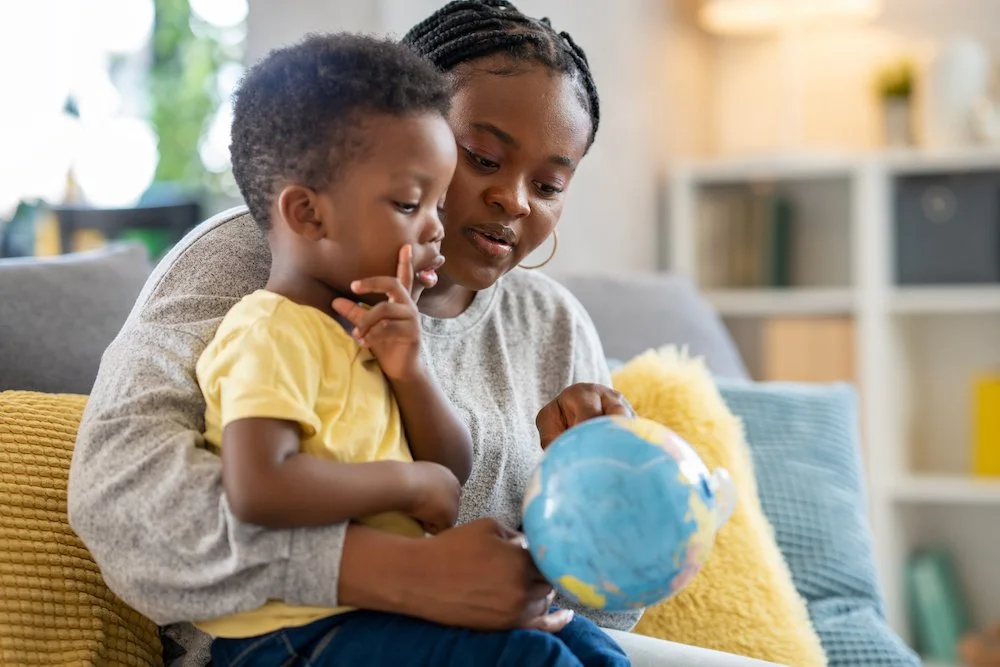What is Joint Attention? And Why Does It Matter?
When we talk about social communication, we’re talking about so much more than just words. Smooth social interaction is COMPLICATED! It’s a wonder any of us can get a message across at all. Seriously. I think about this all the time, and it still amazes me.
Before kids even begin talking, there are foundational skills they need to develop in order to become effective communicators. One of the most important of these early skills is joint attention. If you’ve ever heard this term before but weren’t quite sure what it meant (or why it matters), let’s break it down.
What is Joint Attention?
Joint attention happens when two people focus on the same thing at the same time—and they both know that they’re sharing that focus. It’s more than just looking at the same object; it’s about the connection between people while they’re engaged in an activity together.
In other words, joint attention is what makes an interaction truly shared. It’s the difference between just being near someone and actually engaging with them.
Let’s look at a few examples to highlight the difference:
- Your child sees a plane in the sky and looks at it.
vs.
Your child sees a plane, points at it, looks at you, and then looks back at the plane while you both watch it together.
- You put on music, and your child starts dancing on their own.
vs.
You put on music, and your child takes your hand, looks at you, and dances with you.
- You’re reading a book while your child plays separately.
vs.
You’re reading a book, and your child looks at the pictures with you, turning the pages as you both focus on the story.
See the difference? It’s subtle, but incredibly important.
Why is Joint Attention So Important?
Joint attention isn’t just a nice bonus—it’s a foundational skill that supports almost every aspect of social and emotional development. It’s what helps kids learn how to engage with others, take turns, and understand that communication is a two-way street.
Here’s what joint attention leads to as kids grow:
- Taking someone else’s perspective – Understanding that other people have their own thoughts, feelings, and experiences.
- Collaborating on projects – Working together toward a shared goal, whether it’s building a tower, solving a puzzle, or playing pretend.
- Having conversations – Knowing how to take turns in a discussion, respond to what someone else says, and stay on topic.
Without joint attention, these skills don’t develop as easily.
Regulation Comes Before Joint Attention
It’s important to mention that before a child can engage in joint attention, they need to be regulated—meaning they need to feel safe, calm, and emotionally stable. See my recent post on Co-regulation (which is a form of regulation for kids).
Think about it: If a child is overwhelmed, anxious, or dysregulated, it’s really hard for them to focus on what someone else is doing. Their brain is too busy trying to manage their own emotions and sensations and keep them safe.
So, if you notice your child struggling with joint attention, the first step is to check in on their regulation. Are they feeling safe and connected? Are they in a good place to engage with you? If not, focusing on co-regulation (helping them feel calm and stable) is a great starting point.
What If My Child Struggles With Joint Attention?
If you’ve noticed that your child doesn’t naturally engage in joint attention—or if they tend to focus more on objects than people—you’re not alone. Some kids develop this skill more easily than others, and some kids with sensitive nervous systems may need extra support to build it.
Here are a few things you can try:
- Make it fun! Turn joint attention moments into games. Point at something interesting, make an excited face, and wait for your child to look at you before reacting.
- Use exaggerated expressions. Kids tend to naturally tune into faces, so if you show big, enthusiastic reactions, they’ll be more likely to engage with you. (Note: if this is alarming to your kiddo, DON’T!)
- Follow their lead. Instead of directing them to look at what you find interesting, notice what they are already looking at and join them in that experience.
- Be patient. Building joint attention takes time, especially if your child isn’t naturally drawn to it. Every small moment of connection counts.
Have Questions? Let’s Talk.
If you’re wondering whether your child is demonstrating joint attention, or if you’ve already noticed that they’re not, you don’t have to figure it out alone.
Joint attention is a big milestone in social development, and if it’s not happening naturally, there are ways to support and strengthen it. Every child develops at their own pace, but if you’re feeling unsure or just want to talk it through, reach out. I’m happy to help.
Because at the end of the day, communication isn’t just about words—it’s about connection. And connection starts with attention, shared experiences, and the simple act of looking at something together.
